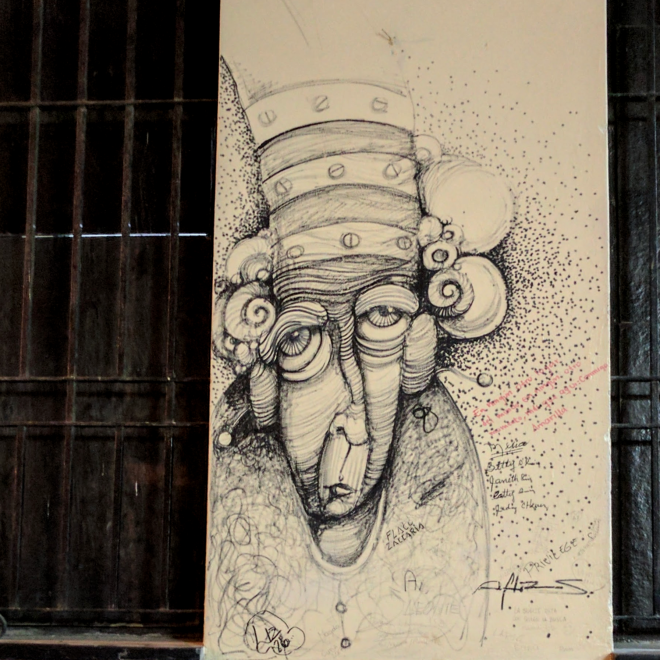The daiquiri is probably the most tangible illustration of the incongruity between the Cuba of tourist fantasy and reality. We want to see Hemingway’s Havana, but that’s a place that hasn’t existed in over half a century.
Every tourist trap and paladar in Havana will make you a frozen daiquiri. It can be a treat after spending all day in the heat and humidity of the city, but it’s about as true to tradition as the neon plastic straws that poke out of each glass.

If you do find yourself at a paladar with a classic daiquiri on the menu, you’ll still get a frozen one unless you specify. Such was the case at Casa Miglis, a Swedish-Cuban fusion paladar and what ended up being one of our favorite restaurants. The interior was cobbled together out of several rooms in what appeared to be adjoining buildings. Sunlight beating through a ceiling made of blue corrugated plastic turned the atmosphere into a real-life Instagram filter. We ordered chili and souvlaki and as it started raining, a small but noticeable drip began to fall in the corner just behind me.
Casa Miglis is part of the growing trend of gourmet paladars in Havana — elevated food beyond the typical Cuban fare, with a nod to traditional drinks like the shaken daiquiri. Nevertheless, the impulse remains to serve what most tourists think they want: frozen sludge.

Even at the establishment most famous for its daiquiri, El Floridita, the goal is to churn out as many frozen versions as possible.
We found our way there, along with a tide of other tourists, after a sweaty day of sightseeing around Habana Vieja. When we walked in, it was so frenetic with iPhone-wielding yumas that we almost left its rarified air conditioning behind and walked back out into the heat.
If you wait for a seat, you’ll notice the natural flow of business. Elbow your way to the bar and order your frozen daiquiri. Clamor through the crowd to the corner where a stoic Hemingway statue smiles for photos. Suck down your slushy and move on to the next attraction.
A band plays sets of three or so songs attuned to this schedule, which means as straws slurp at the dregs, the singer has time to sashay around the room asking for tips. By the time she’s back to her station by the door, there’s a new crowd waiting to hear the same songs and pose for the same photos.

It’s the quintessential tourist trap, but if you can sit through Chan Chan on repeat, you’ll see what’s made El Floridita a mainstay of Habana Vieja.
On the aforementioned first visit to El Floridita, we decided to resist the ebb of tourists signaled by our empty glasses and stay for another drink — this time, a traditional shaken daiquiri. It took some mild convincing of our bartender, who pointed to our neighbor’s frozen version and said, “This is what we are known for.” We insisted, which seemed to earn us a little credibility with the bartenders.

Despite the potential for decent cocktails at El Floridita, sitting at the bar lends itself more to recognizing the pitfalls of being a vapid tourist than learning anything substantive about Cuba.
Instead, we got our education without even leaving our Airbnb.
On one of our first evenings in Havana, we accepted the somewhat perplexing offer of Ronaldo, the security guard, to make us daiquiris. It turned out that they were the best daiquiris of our trip.

The reason for their superiority is somewhat dubious. It may have something to do with the setting — a breezy balcony at sunset, overlooking the Malecon and ocean beyond, with a Cuban cigar in hand. Ronaldo’s explanation was that he followed a recipe.
Ronaldo was almost 70. He only spoke Spanish, but frequently in allegory, which somehow made it easier for me to understand. He was reserved but spoke with pride of the people of Cuba and Havana, the city he’d lived in his entire life.
Some evenings, we’d invite him to sit and share some rum from a bottle of Havana Club 7 we’d bought at a huge markup at a hotel bar on our first night in Havana. After a glass, he divulged his true secret for the perfect daiquiri — he patted his chest. His drinks were made with heart.

Ronaldo’s counterpart during the day, Vincent, was more animated. He’d pour us drinks and show us the music and movies he collected on his broken laptop from el paquete. He was more up to date on Game of Thrones and the latest Fast and Furious movie than we were, and challenged us to think of an album he didn’t have access to.
El paquete: this is how he’d discovered a world of information beyond the state-run propaganda piped through Cuba’s televisions, newspapers and radio stations. With his offline archive of Wikipedia and Forbes magazine, he learned about Fidel’s massive wealth — “Can you believe it?”
While we sipped rum, he showed us his ration booklet, with lines for anything a household might need. He showed us what he’d been able to procure that month: no meat, no vegetables. Just rice and beans and bread.

After marrying a Spanish woman but failing to get permission to leave Cuba with her, he’d been looking for other ways out. He showed us an informational pamphlet he’d received at the U.S. embassy. After a long, sweltering wait outside the embassy, he’d received this pamphlet with a phone number and a website. For more information, call between 9 and 10 am.
While sat sipping cocktails, counting down our days left on the island, he counted all of the ways he’d tried to leave.

What a great story! You will never have a daiquiri again without thinking about Ronaldo
LikeLiked by 1 person